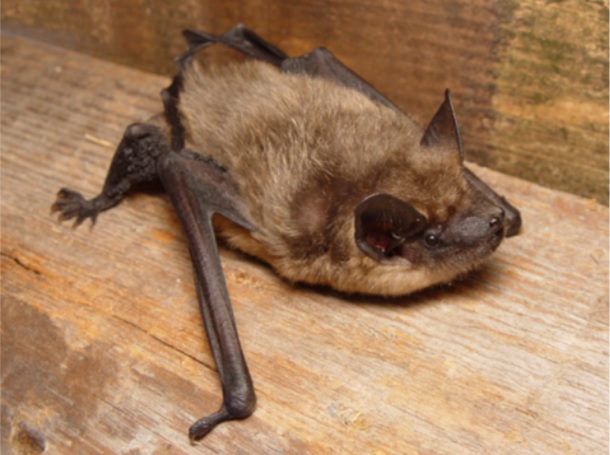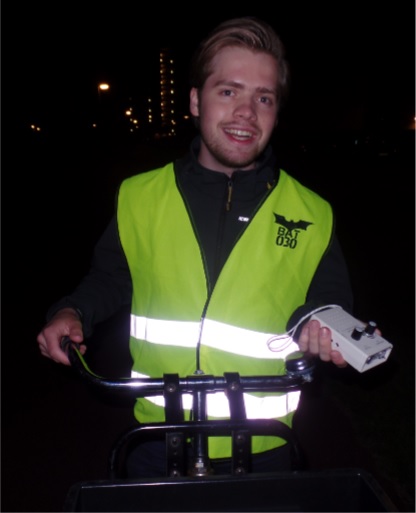
Chasing Bats in Utrecht
Imagine... a beautiful summer night in Utrecht's most beautiful park. The sunset paints the sky in
wonderful tones of yellow and orange. Then, a group of people walk by, staring at the sky and
pointing skywards with a mysterious, beeping device. To make the situation even more suspicious,
they all wear a bright yellow vest... what are they looking for? Aliens? No. Spies? No. Pokemon?
Almost right. They are searching for bats!
To be more specific, this group of biologists is searching for the serotine bat (Eptesicus serotinus),
and I am beeping around with them. The Serotine Bat is one of the largest bat species in the
Netherlands, with a wing span between 32 and 38 centimetres (figure 1). Like all bats, it hunts for
insects during the night, using echolocation. Human beings cannot normally hear this, but we cheat,
using our bat detector which modifies the sound, so that we can hear the echolocation. It resembles
some sort of beeping noise (figure 2, a volunteer with a bat detector).
Bats mostly leave their roosts around sunset (in summer, the females and young stay in nursery
roosts). It often takes only 10 minutes for almost the whole colony to leave the roost.(1) What we
are trying to do, is track down nursery roosts in and around the city. This is done by the following
approach: you wait in a place where bats have been spotted before. The bat detector is used to
locate the bats. Then, if you hear or see a Serotine Bat flying around sunset, you know it has probably
just left the roost. Therefore, you can run to the direction opposite the one the bat is flying in. Here,
you wait until you see another bat flying and repeat this action. With this approach, we hope to
locate the bats and eventually find the nursery roost, via tracking down the flightpaths the animals
use.

Figure 1: A serotine bat. Source.
This project (part of BAT030) was set up by the municipality of Utrecht. Its goal is to find the nursery
roosts in order to offer the bats protection. In The Netherlands, the Serotine Bat is a Red List species
(source) and although accurate figures are still lacking, it is believed that its
numbers have dropped over the last years. However, nursery roosts are difficult to find, as they are
hidden in buildings, hollow walls, and sometimes in trees(2). Additionally, the animals leave their
roosts very quickly and secretively. Between 10 and 50 bats usually inhabit a nursery roosts,
sometimes together with other bat species, such as the common pipistrelle (Pipistrellus pipistrellus).
Like all bats, Serotine Bats have separate winter and summer roosts, but the distance between
summer and winter roosts is usually no farther than 50 km. However, during hibernation the bats are
in torpor, so the chance of seeing them is even smaller (3).

Figure 2: A volunteer (Pascal
Franssen) with his bat detector,
on his bike, ready to chase after
bats in Utrecht. Photo by courtesy
of the author.
Originally, this bat probably did
not breed in the Netherlands, as it
roosted in crevices and natural
caves (which are absent in the
Netherlands). However, when
humans started to build houses,
castles and churches, they found
'caves' and 'crevices' in the form
of slits in old walls, buildings,
rooftops of churches, cavities
between walls of houses, and
spaces under roof tiles. Roosts are
often hidden away, as these bats
are vulnerable for predation
when they are sleeping upside
down during the day(4)(5).
We start our search for the Serotine Bat's roosts at parks, old forts and buildings along the edges of
the city. We know most Serotine Bats fly out of the city at night, to forage in rural areas(4). The bat
often commutes along hedges, parks, lines of trees or other green corridors(6).
As the bats cannot make their own roosts and have particular demands (such as warmth, stable
climate and good access) they do not move to new roosts unless they really have to. They are
therefore philopatric, meaning that they are prone to use the same roosts for decades(7). Therefore,
we can use old maps and observations of bats and try to find the Serotine Bat hotspots of a few
decades ago, since we expect that they are still there. And they are! If you are around Kasteel Oud
Zuilen, Fort de Klop, Vechtzoompark, Fort Blauwkapel or the Wilhelminapark (all in Utrecht), have a
look for the largest bat you can see and you may greet the humble Serotine Bat!




